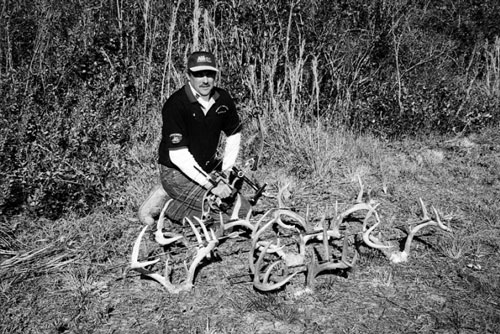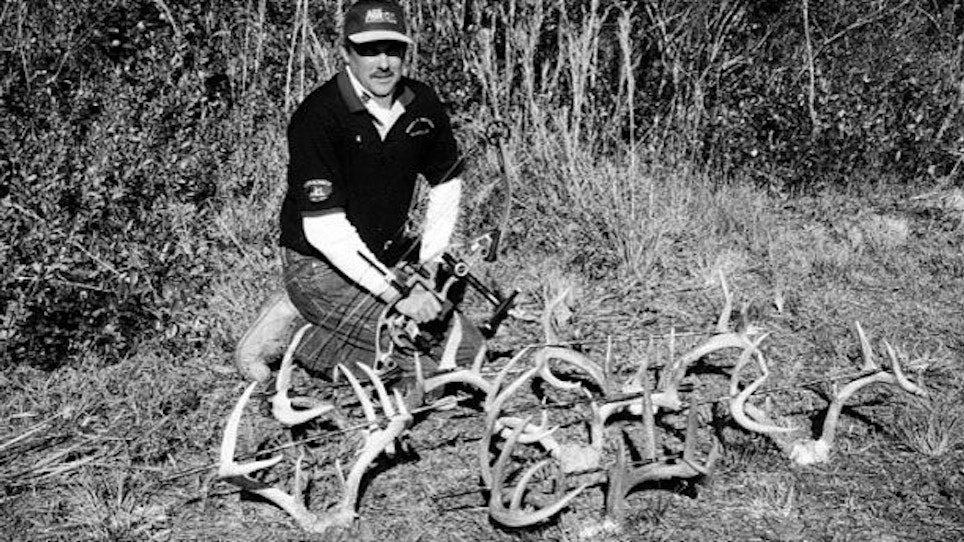 When we unloaded the antlers to take photographs during a 3-D competition in Florida, Greg Pyle and I caused quite a commotion. Archers pointed and waved. If they were driving, they stopped and got out for a closer look. In just half an hour, scores of shooters asked to touch them, hold them, count their points, feel the circumference of their bases. The six racks scored from the 130s to the high 160s.
When we unloaded the antlers to take photographs during a 3-D competition in Florida, Greg Pyle and I caused quite a commotion. Archers pointed and waved. If they were driving, they stopped and got out for a closer look. In just half an hour, scores of shooters asked to touch them, hold them, count their points, feel the circumference of their bases. The six racks scored from the 130s to the high 160s.
“And these are just my culls,” says Pyle of Evansville, Indiana.“I don’t believe deer have changed in the years I’ve been hunting them, but I’ve changed the way I hunt them. I took my first deer, a 13-pointer, with a shotgun when I was 10 years old. Hunting with a gun is still something I enjoy, but now I do most of my deer hunting with a bow. Whatever I use, though, I hunt fence rows 95 percent of the time.”
Fence Rows And Farms
Pyle admits the private land he hunts is loaded with quality deer. “In the Midwest, farmers usually finish harvesting early,” he notes. “They turn the ground and disk it before the snow and ice arrive.
“At my prime hunting spot, the farmer grows 300 acres of corn with antique equipment, so he leaves a lot on the ground. Across the road is a 600-acre plot in CRP, so it isn’t farmed.
“Hunting in farm country, you do have to put up with some things. Farm dogs chase a lot of deer and, occasionally, there are some car and truck drive-by mess-ups, but you just have to take it all in stride.”
When he has a choice, Greg hunts “...fence rows and very small wood lots, under five acres, almost exclusively,” he says. “When I learned how to hunt fence rows, I began seeing deer like never before. Of course, on private land I rarely see other deer hunters, so the deer are not harried and their patterns are more relaxed and natural.”
Corporate greed has not entirely overwhelmed the American breadbasket with “centerline to centerline” plowing, so ruinous to wildlife, recreation and, ultimately, to the land itself. Pyle hunts in areas of the Midwest where farmers value their roles as food growers and stewards of the land. Small wood lots and thickly overgrown fence rows are common in this region and, as a result, there are plenty of deer and rabbits.
“Thick fence rows give deer runways, corridors to and from bedding areas and food sources. Also, they provide superb midday loafing areas,” Pyle notes. “I have often jumped big bucks out of fence rows on my way to a stand. Additionally, bird and rabbit hunters jump deer for you, and these deer cruise fence rows when they can, moving away from these other hunters and their dogs.
It doesn’t take much in farm country to give deer, and especially bucks, a sense of security, Pyle says. “Sometimes, just a bare fence or even a little brush or a small tree or two is enough,” he says. “For the hunter, the skimpier it is, the better, as long as there is one good tree that lets you hang a stand up about 20 to 25 feet.”
In the summer, when Pyle’s carpentry chores are done, he spends evening hours glassing fence rows for deer. “Thin as these rows are, many whitetails bed down in them, getting up occasionally to browse. Plus, fence rows intersect drainage ditches and creeks and provide good visibility. Just about all a deer needs.”






